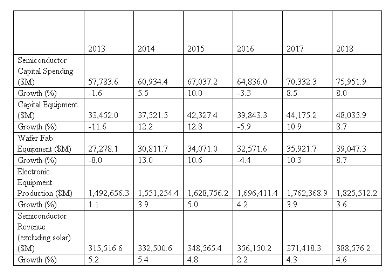  Worldwide semiconductor capital equipment spending is projected to total $37.5 billion in 2014, an increase of 12.2 percent from 2013 spending of $33.5 billion, according to a research from Gartner. Capital spending will increase 5.5 percent in 2014 as the industry begins to recover from the recent economic downturn and total spending will follow a generally increasing pattern in all sectors through 2018.
"While capital spending outperformed wafer fab equipment (WFE) spending in 2013, the reverse will hold for 2014," said Bob Johnson, research vice president at Gartner. "Total capital spending will grow by 5.5 percent, while WFE will increase 13 percent as manufacturers pull back on new fab construction and concentrate in ramping new capacity instead. Momentum from exceptionally strong fourth-quarter 2013 sales is carried forward into the first quarter, then is expected to bounce around a flat trend line through the remainder of 2014. In the longer-term profile, growth continues through 2015, dips slightly in 2016 and increases through 2018."
Logic spending remains the key driver of capital spending throughout the forecast period, but due to the anticipated softening of mobile markets it will grow less than memory. Memory will provide most of the growth in capital spending through 2018, with NAND Flash being the primary impetus.
Capital spending is highly concentrated among a handful of companies. The top three companies (Intel, TSMC and Samsung) continue to account for more than half of total spending. Spending by the top five semiconductor manufacturers exceeds 64 percent of total projected 2014 spending, with the top 10 accounting for 78 percent of the total.
Gartner predicts that 2014 semiconductor capital spending will increase 5.5 percent, followed by 10 percent growth in 2015. The next cyclical decline will be a slight drop of 3.3 percent in 2016, followed by a return to growth in 2017 and 2018 (see Table 1).
Worldwide Semiconductor Manufacturing Equipment Spending Forecast, 2013-2018
(Millions of Dollars)

Semiconductor inventories combined with overall market weakness depressed utilization rates at the end of 2013. Although demand from smartphones and media tablets is producing leading-edge demand for logic production, it is not enough to bring total utilization up to desired levels. Gartner expects utilization rates to climb upward again in 2014, as demand for chip production returns, and overall utilization rates will return to normal levels through 2014, providing continued impetus for capital investment.
Overall wafer fab manufacturing capacity utilization responded to increasing inventories at the end of 2013 by staying in the low-80 percent range at the end of 2013. In 2014, a return to more normal inventory levels will propel overall utilization of almost 90 percent by year end. Leading-edge utilization will remain in the mid-90 percent range through 2014, providing for a positive capital investment environment.
The capital spending forecast estimates total capital spending from all forms of semiconductor manufacturers, including foundries and back-end assembly and test services companies. This is based on the industry's requirements for new and upgraded facilities to meet the forecast demand for semiconductor production. Capital spending represents the total amount spent by the industry for equipment and new facilities.
The WFE forecast estimates market revenue based on future global sales of the equipment needed to produce the wafers on which semiconductor devices are fabricated. WFE demand is a function of the number of fabs in operation, capacity utilization, their size and their technology profile. |